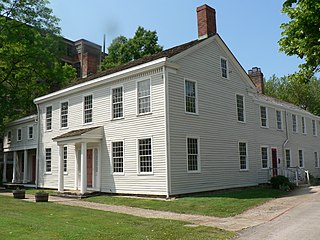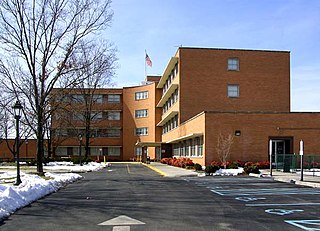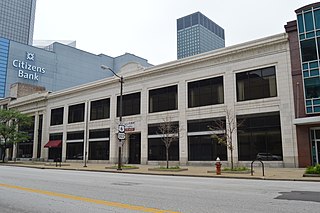
Huntington is a city in Cabell and Wayne counties in the U.S. state of West Virginia. The seat of Cabell County, the city is located at the confluence of the Ohio and Guyandotte rivers in the state's southwestern region. The population was 46,842 at the 2020 census, and was estimated to be 45,325 in 2023. Huntington is the second-most populous city in West Virginia. The Huntington–Ashland metropolitan area, spanning seven counties across West Virginia, Kentucky and Ohio, had an estimated population of 368,262 in 2023.

The Warehouse District is a nationally recognized historic district located in downtown Cleveland, Ohio. It is roughly bound by Front Avenue, Superior Avenue, West 3rd Street, and West 10th Street.

University Circle is a district in the neighborhood of University on the East Side of Cleveland, Ohio. It is home to the Cleveland Museum of Art, Severance Hall, the Cleveland Institute of Art, the Cleveland Cinematheque, Case Western Reserve University, the Cleveland Institute of Music, the Museum of Contemporary Art Cleveland, the Cleveland Botanical Garden, historic Lake View Cemetery, the Cleveland Museum of Natural History, and University Hospitals/Case Medical Center.

Taunton State Hospital is a psychiatric hospital located on Hodges Avenue in Taunton, Massachusetts. Established in 1854, it was originally known as the State Lunatic Hospital at Taunton. It was the second state asylum in Massachusetts. Most of the original part of the facility was built in a unique and rare neo-classical style designed by architects Boyden & Ball. It is also a Kirkbride Plan hospital and is located on a large 154-acre (62 ha) farm along the Mill River.

Ohio City is one of the oldest neighborhoods in Cleveland, Ohio. It is located immediately west of the Cuyahoga River.

The West Side Market is the oldest operating indoor/outdoor market space in Cleveland, Ohio. It is located at the corner of West 25th Street and Lorain Avenue in the Ohio City neighborhood. On December 18, 1973, it was added to the National Register of Historic Places.
The May Company Ohio was a chain of department stores that was based in Cleveland, Ohio, United States.

Dollar Bank is a full-service regional savings bank serving both individuals and business customers, operating more than 90 offices throughout Pennsylvania, Ohio, Maryland, and Virginia. The bank's corporate headquarters is in downtown Pittsburgh alongside its Pennsylvania regional headquarters. The Ohio headquarters is located in downtown Cleveland, and the Virginia headquarters is located in Hampton Roads.

The Dunham Tavern, also known as the Dunham Tavern Museum, is the oldest building in Cleveland, Ohio, located at 6709 Euclid Avenue. Rufus and Jane Pratt Dunham built their first home on the site in 1824, and the existing taproom was built in 1842. It is believed to be the first building constructed on Euclid Avenue east of East 55th Street and the first frame house on the street. It later became a stagecoach stop and tavern.

Downtown Columbus is the central business district of Columbus, Ohio. Downtown is centered on the intersection of Broad and High Streets, and encompasses all of the area inside the Inner Belt. Downtown is home to most of the tallest buildings in Columbus.

Antlers Hotel is a historic hotel building in Lorain, Ohio, it was listed on the National Register of Historic Places November 30, 1982.

The Cambridge Home for the Aged and Infirm is an historic building on 650 Concord Avenue in Cambridge, Massachusetts. Built in 1928 by the city, it is one of the oldest surviving municipal facilities for the housing of elderly and incurably ill patients, rather than indigents. It is now operated as Neville Place, an assisted living community managed by Senior Living Residences. The building was built in 1928 by Charles Reggio Greco and added to the National Register of Historic Places in 2002.

This is a list of the National Register of Historic Places listings in Cleveland, Ohio.

Hough is a neighborhood situated on the East Side of Cleveland, Ohio. Roughly two square miles, the neighborhood is bounded to Superior and Euclid Avenue between East 55th and East 105th streets. Placed between Downtown Cleveland and University Circle, Hough borders Fairfax and Cedar–Central to the South and Glenville and St. Clair–Superior to the North. The neighborhood became a target for revitalization during the mid-20th century, after the 1966 Hough Riots.

Bullock's Pasadena, in Pasadena, California, is a 240,000-square foot (21 368 m²) Late Moderne architectural style building. Built in 1947, it is listed on the National Register of Historic Places.
Robert Andrews Little (1919–2005) was a modernist architect based in Cleveland, Ohio. He received the Cleveland Arts Prize for Architecture in 1965. Little practiced in the Bauhaus and International styles. He also designed and advocated energy-efficient features, and employed Jewish and African-American architects and engineers.
The Cuyahoga Metropolitan Housing Authority (CMHA) is a governmental organization responsible for the ownership and management of low-income housing property in Cuyahoga County, Ohio. The organization was founded in 1933, making it the first housing authority in the United States.

Burrell Memorial Hospital, currently operating as Blue Ridge Behavioral Health (BRBH) Burrell Center, was an historic African-American hospital originally located in the Gainsboro neighborhood of Roanoke, Virginia. The hospital replaced the 1914 Medley Hospital. It opened March 18, 1915 as a 10-bed facility in a converted home at 311 Henry Street. In 1921 the hospital moved to a new, 55-bed location in the adjacent Harrison Neighborhood, having renovated the former Allegheny Institute at 611 McDowell Ave., NW. The final facility was constructed 1954-55 on the same property as a four-story, 73,000 square foot, International Style building. It is T-shaped with three wings extending from a central elevator core. The building housed the only African-American medical facility in Roanoke from 1915 to 1965. It was listed on the National Register of Historic Places in 2003. Burrell Memorial Hospital closed in 1979 due to financial strain and reopened the same year as the Burrell Home for Adults, an adult care facility. This facility grew to provide specialized care to residents, but eventually closed as Burrell Nursing Center in 2002.

The Bryant Building is a historic retail building located in Cleveland, Ohio, in the United States. The building, designed by the prominent local architectural firm of Christian, Schwarzenburg and Gaede, was constructed by Mall Motor Co. as their new salesroom and service center, and was completed in 1921. The structure was purchased by Bryant Motor Co. in 1922.

The Cedar Glen Apartments is a historic apartment building located in the University Circle neighborhood of Cleveland, Ohio, in the United States. Designed by prominent local architect Samuel H. Weis and completed in 1927, the building originally contained luxury apartments and served as a gateway to the more exclusive neighborhood of Cleveland Heights, on whose border the building is located. Threatened with demolition in 1992, the building was purchased by new owners and converted into condominiums.





















